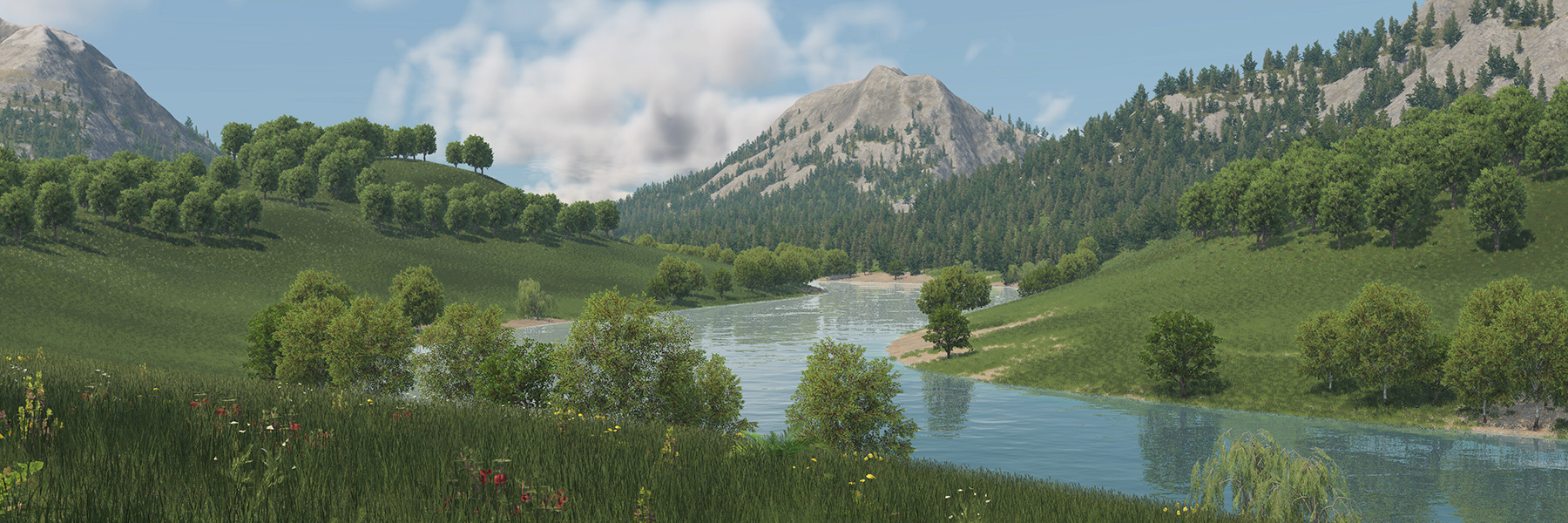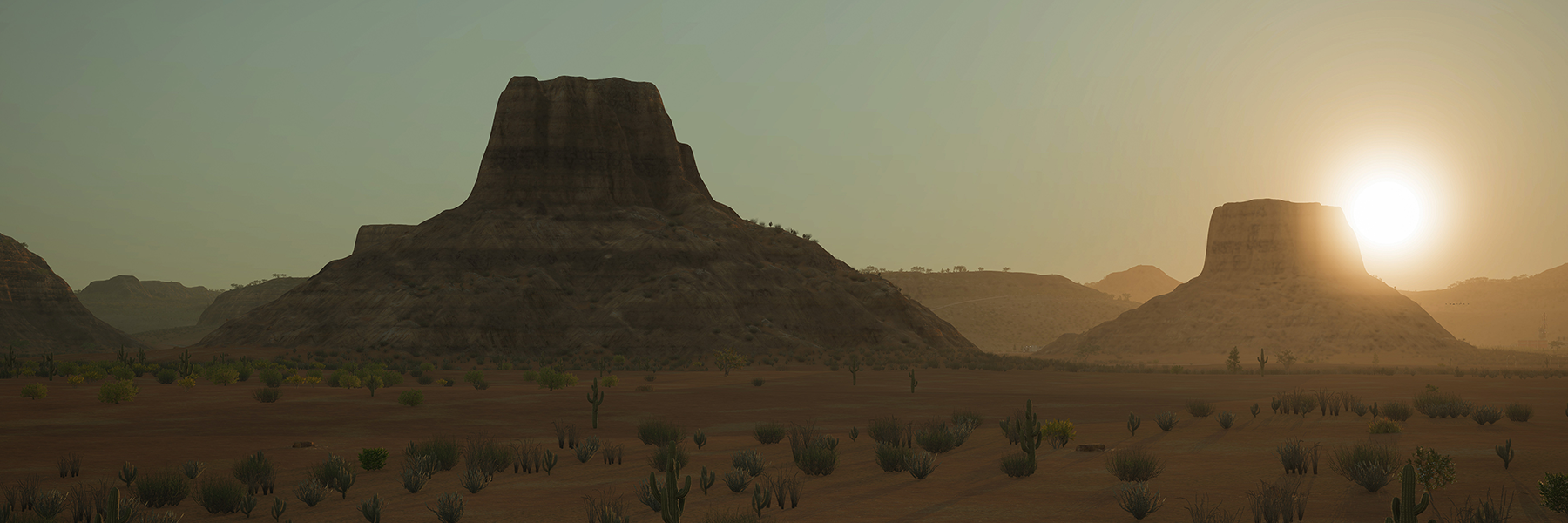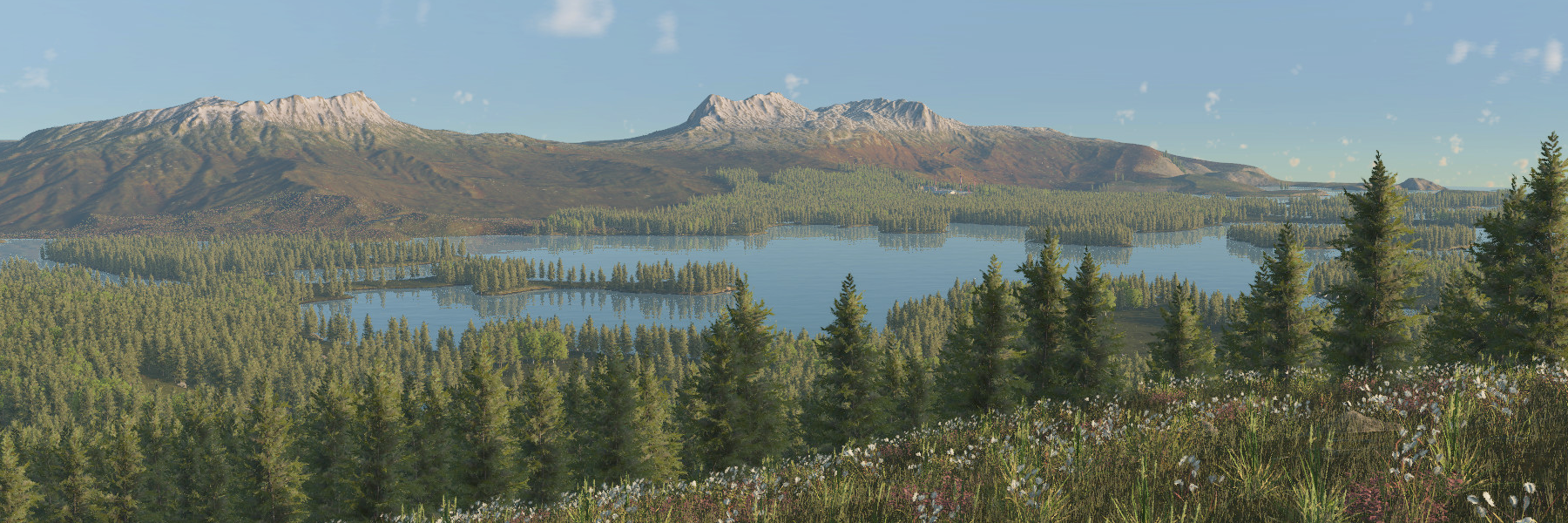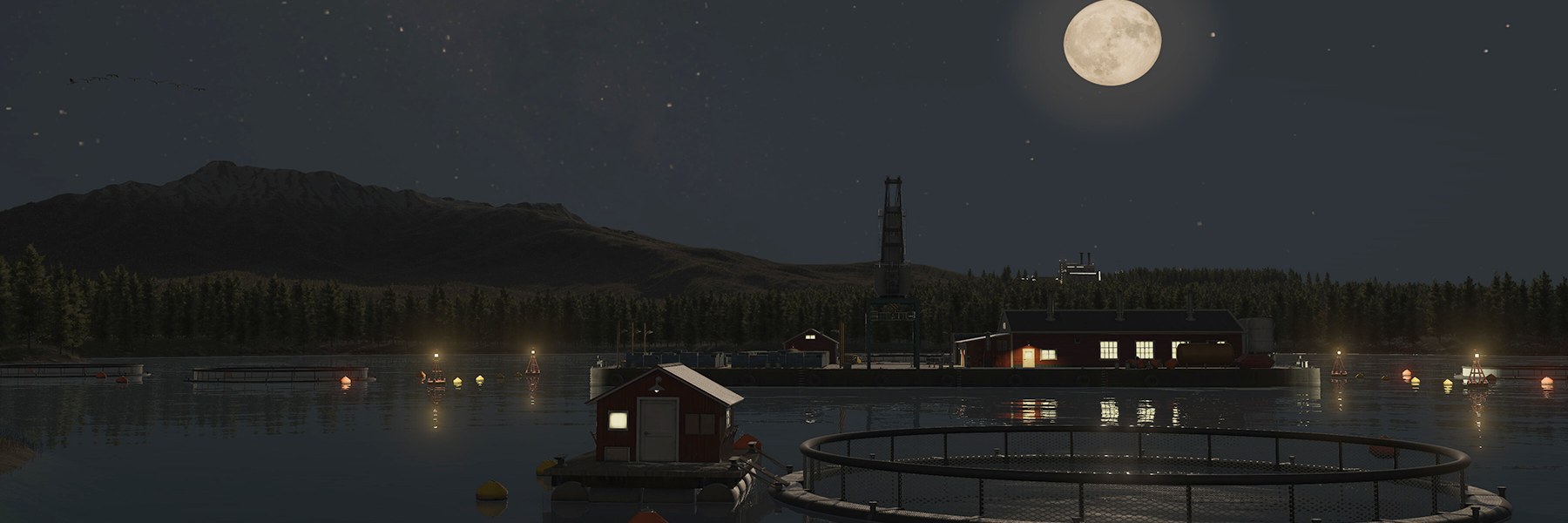Dev Blog – Episode 1: Environment
Welcome to the first installment in our Dev-Blog series, where we’ll be taking a closer look at the technical background behind the content of the First Look video series. In this article covering the first video, we’ll not only give you a glimpse into the diversity of climate zones and atmospheres in Transport Fever 3, but also show how new tools offer even more modding possibilities.
Procedurally generated maps have always played an important role in the Transport Fever series. They offer countless possibilities and ensure that no two playthroughs feel the same. For Transport Fever 3, the variation has been taken to a new level. This is achieved by giving each climate zone different biomes with unique characteristics that can be arranged in a random fashion when generating maps. In addition, advanced terrain materials with more detailed vegetation and a completely dynamically calculated atmosphere provide visual highlights that give the maps a unique look and individuality.
Four Climates - Plenty of Challenges
In all four climate zones, the balance between the different biomes can be adjusted when creating maps, allowing each map to be weighted according to the player’s preferences. But even with the same initial settings, no two maps are alike: the maps can be regenerated with a different random distribution of biomes, resulting in completely different challenges with unique focuses. Let’s first take a look at the new features of each climate zone and the challenges they present to the player:
The Temperate Climate offers numerous aspects of these regions: large mountain ranges, green meadows, dense mixed forests, hilly terrain, and inland lakes. During map generation, players can adjust the weighting between the individual landscape features. By combining these biomes, entirely new landscapes can now be created. When planning transport chains, one must ask oneself questions such as whether the cargo should be transported by ship across the lake or whether the train should transport it all around. Building railway lines may be easy in flat areas, but it becomes difficult in the mountains or along steep coastlines. Should the railway line follow the course of the river or take a shortcut through the mountain using a tunnel? Finding the right route can thus become a tricky undertaking. Or maybe it’s just a good excuse to use a helicopter after all.
In the Tropical Climate, there are scattered islands of various sizes instead of a large landmass. The generator offers various options for adjusting the ratio between landmass and water. Each island has its own character: some offer areas for agriculture, others are covered by dense jungle or dominated by high mountains. This makes the construction of railway lines almost impossible, and even laying down roads is tough. Offshore industries at sea are easier to reach though, whether by helicopter or ship. Together with conventional aircraft, helicopters are also suitable for transporting larger quantities between islands, where the distance makes building bridges or tunnels too expensive: at least where steep coasts do not prevent the construction of ports.
In contrast, the Dry Climate has significantly less water and is dominated by classic deserts, chains of hills, and mesa plateaus. Depending on the player’s weighting, there may be some lakes and rivers, but no seas and certainly no dense forests. The flat areas vary greatly: some resemble savannas with scattered bushes, others are dry desert areas. However, this does not mean that route planning is easy. Mountains rise at the edge of the lowlands, some of which are easier to climb than others. These plateaus and mountains vary greatly in shape and form, adding not only visual diversity, but also structural challenges. The highway cannot always run straight upward: in some cases, larger detours or tunnels are needed to reach suitable locations for a ramp. Where rivers meet the high plateaus, they cut steep-sided, impossible-to-climb gorges into the landscape. Especially when industries are located on different plateaus, sometimes the only solution is to build a massive bridge or switch to air transport.
Finally, the brand-new Subarctic Climate completes the quartet. It is characterized by fjord landscapes and swamps, extensive pine forests, tundra, and mountain ranges. It is up to the players to decide whether they want more marshlands or high mountains. The rugged marshlands are a challenge for all modes of transport, as they are often impassable for ships and usually require expensive bridges or dams for railways. Roads quickly become very winding. In contrast, the fjords are perfect for shipping routes. Crossing the high mountain ranges, on the other hand, is yet another challenge that can have a major impact on the efficiency of the entire transport network, depending on the choice of route and mode of transport.
Dynamic Atmosphere and Sky
But it’s not just the landscape that’s important for creating an impressive environment: the sky also plays an important role. Few things influence the overall mood as much as the sun, clouds, and time of day.
Unlike in Transport Fever 2, the sky is no longer a static skybox but is dynamically calculated by the game in real time. This now makes it possible to have an individual and changing atmosphere with its own lighting conditions for each climate zone. Not only the time of day and cloud cover, but also atmospheric parameters can be directly influenced. At dusk, the world is bathed in a warm light, and as night falls, a clear starry sky provides its own unique highlights. With a little luck, you can even spot the Milky Way, provided there are no clouds blocking the sky and casting their shadows on the world.
For modders, it’s possible to dive even deeper, as the atmospheric model, responsible for creating those beautiful horizon colors and moody sunsets, has plenty of parameters that can be tweaked. Want to ensure the sun sits at the right point on the horizon? No problem, you can set the latitude and change the sun’s path across the sky. Golden sunsets are entirely possible as well, as there are plenty of parameters for colors, intensities and many more aspects of the simulated atmosphere. It is even possible to tweak the haze density! Whether you prefer clear skies or dense fog for a metropolitan map, it’s just a matter of selecting the right values. The same applies to the clouds. You can decide whether they are high above in the sky or if they are hanging low between the mountain tops. All these options are accessible through the extended debug window and can be saved directly into a configuration file.
Node-based Map Generation
If you really want to get to the core of map generation, you will surely be excited to hear that the underlying distribution of elements in new maps has been revamped. The technical system on which map generation is based has been fundamentally overhauled. This benefits the modders as well, as the toolchain that was developed to realize map generation is available for everybody. But how does map generation actually work?
For the four climate zones described above, the following steps are performed on map generation:
- Map division into sub-biomes like water bodies, hills, and mountain ranges
- Generation of the heightmap for the individual sub-biomes and combination based on the distribution from the previous step
- Addition of elements like rivers or volcanos where they fit
- Initial distribution of trees, rocks and other major decorative elements
While map generation in Transport Fever 2 was based on a layer stack similar to layers in photo editing software, the generator in Transport Fever 3 is now node-based. This allows more data to be forwarded, recomputed and shared across the different stages of map generation. Handling these properties manually is a very work-intensive process, so a new interactive editor is provided that will help with a visual setup for the generator stages: either from scratch or by customizing an existing climate.
Thanks to the visual representation of the generator’s logic, including phases and data flow, it’s easier to understand how everything fits together and how it can be tweaked to the individual liking. It is even possible to dry-run parts of the generator separately to preview intermediate results. If you want to see the set-up in action, the whole generation can be tested in the map editor, as the Terrain Generator Editor is directly embedded. No need to restart the game after making changes. This way, ideas can be quickly tried out and refined until the world looks exactly how you want it to feel and play.
It’s not just the terrain that’s more flexible – terrain materials are too. In addition to the grass textures familiar from Transport Fever 2, terrain materials can feature individual plants, stones, and other small objects which will automatically appear wherever that material is used: ferns in the forest, wildflowers in meadows, scree on rocky slopes. This breaks up monotony and gives the landscapes their individual flair.
As in Transport Fever 2, terrain materials are dynamically distributed across the landscape and they adapt to changes that happen during gameplay. The distribution algorithm is based on the same node-based approach as the terrain generation described above. It takes both the height profile and biome layout into account, allowing for a diversified look with different styles, even for areas at the same elevation.
Challenge Yourself!
Our goal is to make Transport Fever 3 a fun and immersive experience with every playthrough feeling unique. Hence it’s more than just changing landscapes and moods – every climate has its own economical focus and industries spawn in appropriate biomes leading to new challenges. But that’s a topic for the next time …
Matthias Gürtler
Lead Product Engineer








16 Responses
What does the edge of the map look like in this one?
Looking forward to it. Hopefully, it’s not released in a beta state such as the disastrous release of Cities:Skylines II.
Was hoping for weather this time around. Doesn’t look like weather will be included in TF3. Disappointing. Still looks like an exciting installment ahead though.
Sounds and looks stunning, different biomes on the same map, i hope there are differences in gameplay as well.
Those dev blogs are real torture, because it is still so much time until release 🙁
Incredible work. It is night and day (pun intended) compared to the second of the name.
Like already mentioned, weather would be the perfect icing on the cake. Nothing else could let you truly feel a moment in time than the current weather. Obviously, it could be debated, but only cosmetic here, impact on gameplay is not needed in my opinion. But snow in toundra region, is !
All my gratitude towards you !!! Keep up the good work and take your time.
How does the water generation work? Is the water at a constant Z level or do rivers flow downhill?
I really REALLY want to see this… flowing rivers and flooding would be amazing
+1
I would also like to know that. Somehow the commentary from Colonel_Failure in the video suggest that it might be, but never read anything about it that would confirm it.
I would also like to know that. Somehow the commentary from Colonel_Failure in the video suggest that it might be, but never read anything about it that would confirm it.
I’ve said this before on the Steam forums and possibly here, but PLEASE don’t lock off climates from one another. There is no good reason why I shouldn’t be able to generate a temperate map where the southern section, either randomly or chosen manually in the map generator, can’t be a dessert or a snowy landscape. Yes, I know we’ll likely be able to decorate maps with the different climate terrain brushes with certain mods, but I want the ability to randomize it. I.e., the map generator should be able to generate a part of the map as dessert, temperate, sub arctic and even tropical depending on the seed and the slider settings in the map generator. For example, if you only want temperate and dessert climates/environments on your map, a slider would be able to choose the percentage of them, say temperate 80% and dessert climate at only 20%. Then you could control the sliders for the different biomes of them. For example, the percentage of how many mesas appear in the dessert part of the map. I get this would mean extra work but it would really give each map far more character and challenges!
Ignore the misspelling of desert as dessert. I was very tired… and hungry 😀
That moon is way too huge. And the night-sky (plus environment) should be darker.
Looks fantastic, really liking the vibe of the new subartic climate! Can’t wait to try this out!
I hope, since terrain challenges are a key factor of the new maps, that this will also be included in the revenue. For example building a train line over a mountain pass takes not only much more time, but also increases the real travel distance a lot, compared to the air-line distance. In the previous games this was economically not always feasible, because of how the revenue was calculated.
For me a train line over the mountains with serpentines and spiral tunnels is always an economical challenge, since the operating costs keep building up, but the revenue at the destination often doesn’t break even.
Agree, would also like to see that revised.
The only game were diversity is a good thing .(biomes and so on)
It would be nice if river altitude was finally dynamic, so rivers would “flow” downstream. Tracks along a river are no longer forced to be even bit could go down/uphill.